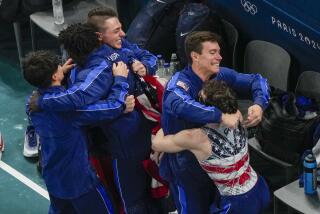Maccabiah Athletes Earn Medals--Plus : Cultural Experience Rates High Among Competitors in Tel Aviv ‘Olympics’
- Share via
With much of the color, pomp and pageantry of last summer’s Olympic Opening Ceremonies, 4,000 athletes from 38 nations marched into Ramat Gan National Stadium in Tel Aviv on July 15, marking the commencement of the 12th Maccabiah Games.
As they took their places in ranks and rows on the stadium floor, a solitary figure jogged into the stadium, torch in hand, and ascended the platform to kindle a ceremonial flame and formally begin the Games. The crowd erupted as it recognized its past champion--swimmer Mark Spitz.
Over the next 10 days, the athletes--525 of them on the U.S. team--participated in 32 sports in what is often called the Jewish Olympics. The $4-million athletic festival is the third-largest international competition and includes events from clay pigeon shooting to gymnastics, tennis to synchronized swimming. It provides Jewish athletes from around the world the opportunity to compete against each other.
Spitz holds fond memories of his two trips to Israel, in 1965 and 1969, to participate in the Games. “At age 15, it gave me the opportunity to experience international competition,” he said. “I tied one of my own world records there.”
Spitz considers Maccabiah participation “a remarkable experience, a stepping stone in an athlete’s career. The fact that they’ll experience the thrill of international athletic competition will help them socially . . . and will be long-lasting and memorable.”
He said that because fewer than 20% of the athletes that compete in the Games go on to represent their country in the Olympics, the social and cultural aspects of the international competition take on additional importance.
Spitz said he helped with some fund-raising events and subsidized an athlete. The teams were sponsored by the U.S. Committee Sports for Israel (USCSFI), a nonprofit organization that promotes sports and educational programs in Israel. It costs about $3,000 to send each U.S. athlete; the money was raised primarily through private and corporate donations.
The Games were founded by Yosef Yekutieli, who in 1929 suggested a convocation of Jewish athletes in Palestine. In the spring of 1932, with 22 participating nations and 13 American athletes, the first Maccabiah Games were held, named after Judah Maccabeus, a Hebrew religious hero of 200 BC, who used his physical strength to help secure religious freedom.
In 1938 the Games were canceled because of world events and were resumed in 1950 in the newly created state of Israel. Since 1957 the Games, which are recognized by the International Olympic Committee, are held quadrennially the year following the Olympics.
A number of American athletes--such as gymnast Mitch Gaylord, and the NBA’s Larry Brown, Ernie Grunfeld and Danny Schayes--have participated in the Maccabiah Games and gone on to the college, professional and Olympic ranks.
Although the Maccabiah movement is much stronger on the East Coast and in other countries, the Games remain relatively obscure. This year, however, the Games were filmed for ESPN by Joe Siegman, a Los Angeles-based producer and a member of the U.S. lawn bowling team.
When the competition and arts festival conclude today, the athletes will march through the streets of Jerusalem and to the Western Wall for the Games’ closing ceremonies.
When Spitz marched out after the ’65 Games, he had set some personal bests. None, however, were as significant as a personal first.
“I fell in love for the first time in my life at the Maccabiah Games,” he said.
More to Read
Go beyond the scoreboard
Get the latest on L.A.'s teams in the daily Sports Report newsletter.
You may occasionally receive promotional content from the Los Angeles Times.






